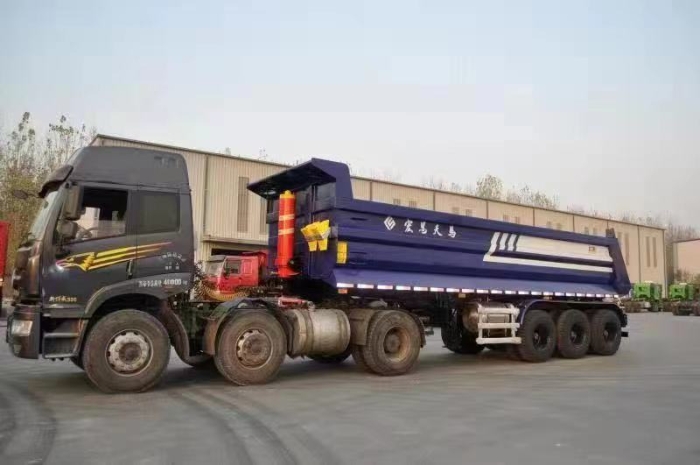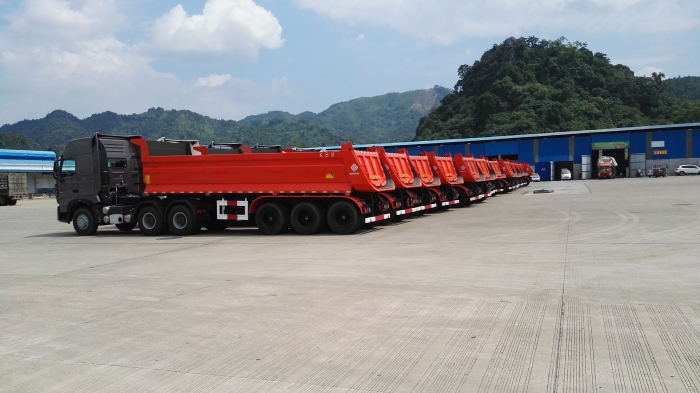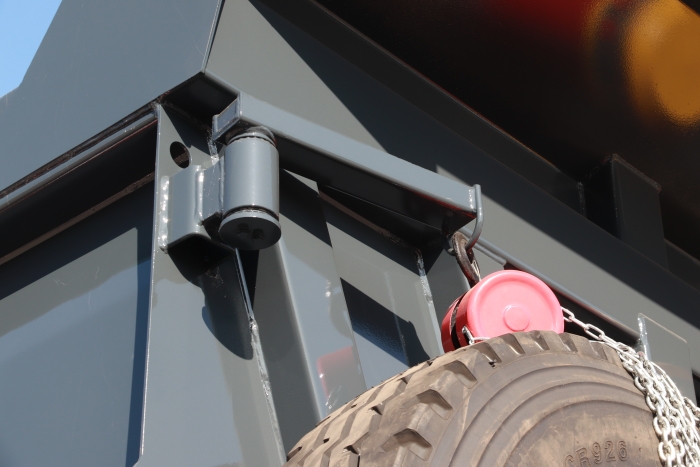- PRODUCTS
- SOLUTION
- SERVICE
- NEWS
- ABOUT US
Yes, drop deck semi-trailers, with their capacity to handle loads up to 80,000 pounds and lengths up to 53 feet, are ideal for transporting oversized equipment due to their low deck heights facilitating easier loading and enhanced safety through securement points.
Oversized equipment, crucial for various industrial operations, encompasses a wide array of machinery and components. Construction machinery, such as excavators, bulldozers, and cranes, stands out due to their substantial weight and dimensions. For instance, a large excavator can weigh over 800,000 pounds and stretch up to 35 feet in height and 30 feet in width. Similarly, wind turbine components are monumental, with blades reaching lengths of up to 250 feet and nacelles weighing approximately 300,000 pounds.
Additionally, the energy sector relies heavily on oversized items like transformers and generators. A single generator for a power plant might weigh between 100,000 to 400,000 pounds. The aerospace industry also transports large parts such as fuselage sections of aircraft, which can be over 100 feet long.

The transportation of oversized equipment presents numerous challenges, primarily due to their massive weight and volume. These challenges include:
Weight and Size Limits: Roads and bridges have specific weight and size restrictions. Transporting a piece of equipment weighing 200,000 pounds or more requires meticulous planning to navigate these limits.
Route Selection: Identifying a route that accommodates the dimensions of the cargo is crucial. This process involves avoiding low bridges, narrow roads, and areas with heavy traffic congestion. Additionally, the need for special permits for certain routes adds complexity to planning.
Safety Considerations: Ensuring the safety of both the transport team and the public is paramount. This includes securing the load properly to prevent any movement during transit and considering the potential for high wind conditions which could affect the stability of high-profile loads.
Cost Implications: The cost of transporting oversized equipment is significantly higher than standard freight. This is due to the specialized trailers required, escort vehicles for safety, and the potential need for road modifications or utility adjustments along the route.
Challenge | Specifics | Implications |
Weight and Size | Excavators: up to 800,000 lbs; Wind turbine blades: up to 250 ft in length | Requires heavy-duty trailers; Special permits |
Route Selection | Avoidance of low bridges, narrow roads | Detailed planning; Increased transit time |
Safety | Securement of load; Wind conditions | Use of escort vehicles; Risk mitigation strategies |
Cost | Specialized trailers; Road modifications; Escort vehicles | Higher transportation costs |
In conclusion, transporting oversized equipment demands detailed planning, specialized equipment, and a deep understanding of the legal and safety requirements. The complexities of moving such large and heavy items necessitate a comprehensive approach to ensure efficient and safe delivery.
Drop deck semi-trailers, renowned for their robust design, offer substantial loading capacities that cater to the transportation of oversized equipment. Typically, these trailers can handle loads ranging from 35,000 to 80,000 pounds, providing a versatile solution for heavy machinery. The deck height, usually around 36 to 42 inches in the lower section, facilitates the accommodation of equipment with heights that would otherwise exceed legal limits on standard trailers.
Moreover, the dimensions of drop deck trailers vary, with lengths up to 53 feet and widths approximately 8.5 feet, allowing for the transport of wide and long machinery. For example, wind turbine blades and large construction machinery, such as cranes and bulldozers, fit comfortably within these dimensions.

The low platform design of drop deck semi-trailers significantly enhances the ease of loading and unloading large equipment. This feature is particularly advantageous for heavy items that cannot be easily lifted high off the ground. The reduced deck height allows for the use of less steep ramps, facilitating safer and more efficient loading operations.
Ensuring the safety of oversized equipment during transit involves several key techniques, focusing on securement and balance. Drop deck trailers are equipped with numerous tie-down points to adequately secure loads, preventing movement or shifting. Furthermore, operators meticulously distribute the weight across the trailer to maintain a balanced load, essential for safe handling and transportation.
Safety measures include:
· Utilizing chains and straps for firm securement.
· Applying wheel chocks for wheeled equipment.
· Employing padding to protect delicate components.
Feature | Specification | Safety Measure |
Loading Capacity | 35,000 to 80,000 pounds | Use of appropriate trailer type based on weight |
Deck Dimensions | Length: up to 53 feet; Width: ~8.5 feet | Strategic load distribution for balance |
Deck Height | 36 to 42 inches (lower section) | Low-height loading ramps for easy access |
Securement Points | Multiple tie-down points | Chains, straps, and wheel chocks for securement |
Incorporating these strategies ensures that drop deck semi-trailers provide a reliable and efficient means of transporting oversized equipment. The combination of high loading capacity, ease of loading/unloading, and stringent safety measures make these trailers an indispensable asset in the logistics of large-scale machinery transport.
Using drop deck semi-trailers for transporting oversized equipment significantly enhances time efficiency. These trailers are designed to accommodate large and heavy loads, allowing for fewer trips compared to standard trailers. For instance, the unique design of drop deck trailers enables them to carry large pieces of construction machinery or wind turbine components in one go, thereby reducing the need for disassembly that would be required with smaller trailers.
Key factors contributing to time efficiency include:
· Direct loading and unloading: The lower deck height facilitates quicker and safer loading and unloading processes.
· Optimized route planning: The ability to carry oversized loads allows for more direct routing, avoiding detours necessary for smaller loads.
Analyzing the cost-effectiveness of using drop deck semi-trailers involves considering various expenses such as fuel consumption, maintenance, and the cost of obtaining special permits. Despite the potentially higher initial investment in drop deck trailers, the overall cost savings in terms of reduced trips, lower labor costs, and minimized equipment wear and tear can be significant.
Comparative analysis of costs associated with using drop deck trailers versus standard trailers might include:
· Fuel Consumption: Larger loads per trip can result in higher fuel efficiency per ton-mile.
· Maintenance Costs: Regular maintenance is crucial, yet drop deck trailers are designed for durability under heavy loads, potentially lowering long-term maintenance expenses.
· Permit Costs: While oversized loads require special permits, the efficiency of transporting larger items can offset these costs.

Ensuring the safety of oversized equipment during transit is paramount. Drop deck semi-trailers employ various techniques to secure loads effectively, including the use of chains, straps, and specific load balancing methods to maintain stability. These measures not only protect the cargo but also ensure the safety of other road users.
Safety strategies include:
· Proper Securement: Utilizing multiple tie-down points to prevent load shifting.
· Weight Distribution: Evenly distributing the load to maintain the trailer's balance and prevent overloading on any axle.
Factor | Drop Deck Semi-Trailers | Standard Trailers |
Time Efficiency | High due to direct loading and optimized routes | Lower due to additional trips and detours |
Fuel Efficiency | Higher efficiency per ton-mile | Lower efficiency per ton-mile |
Maintenance Costs | Potentially lower due to durable design | Higher due to less suitability for heavy loads |
Permit Costs | Offset by larger load capacity and fewer trips | Increased due to multiple trips |
In summary, drop deck semi-trailers offer a highly efficient and cost-effective solution for transporting oversized equipment. The combination of time savings, reduced operational costs, and enhanced safety features underscores the value of these trailers in heavy haulage operations.